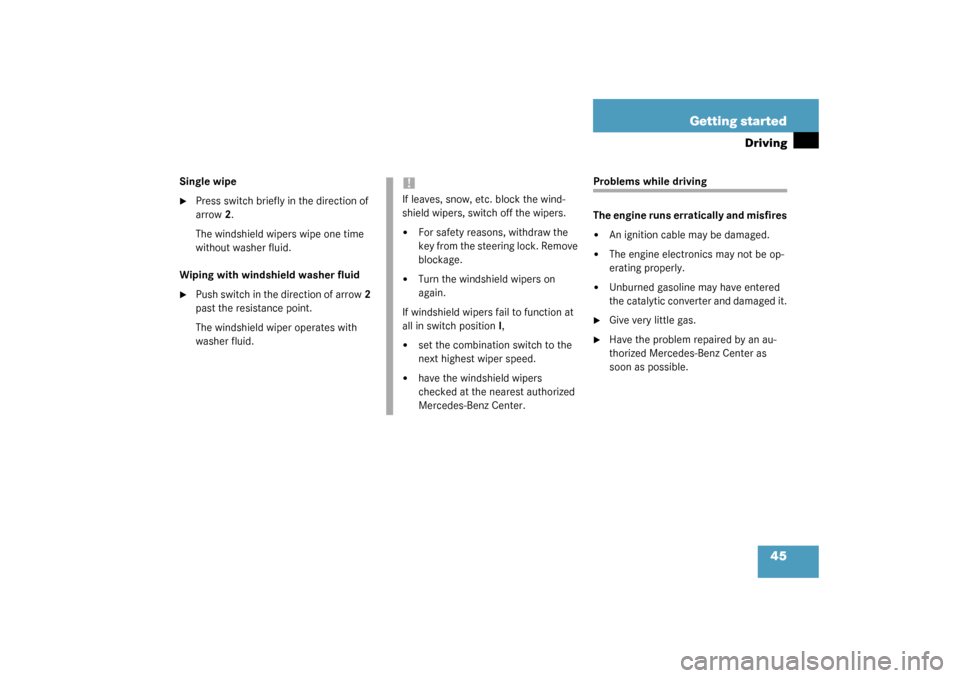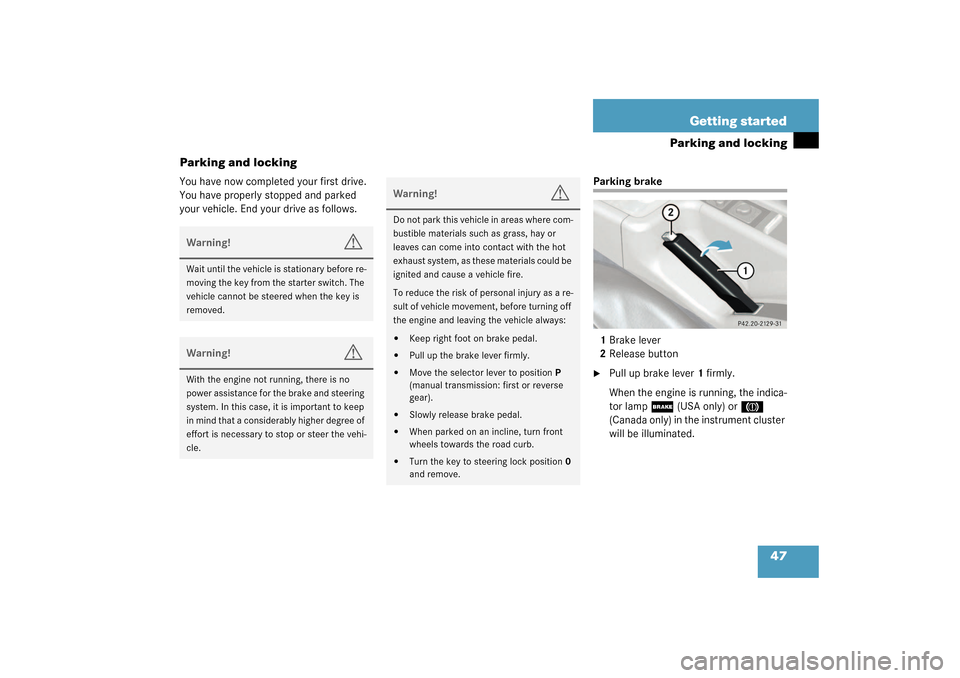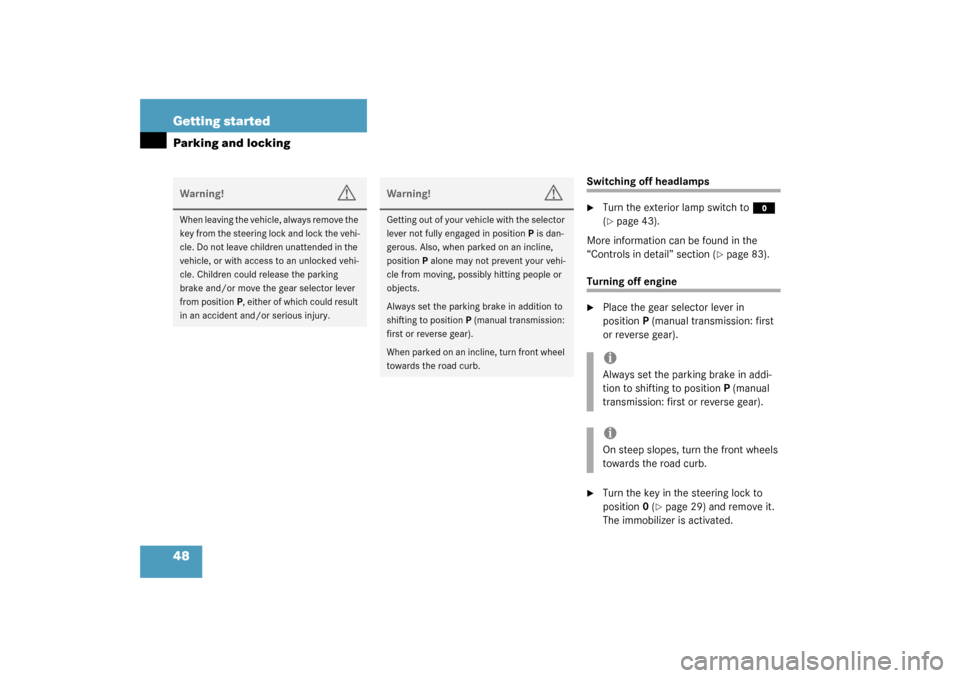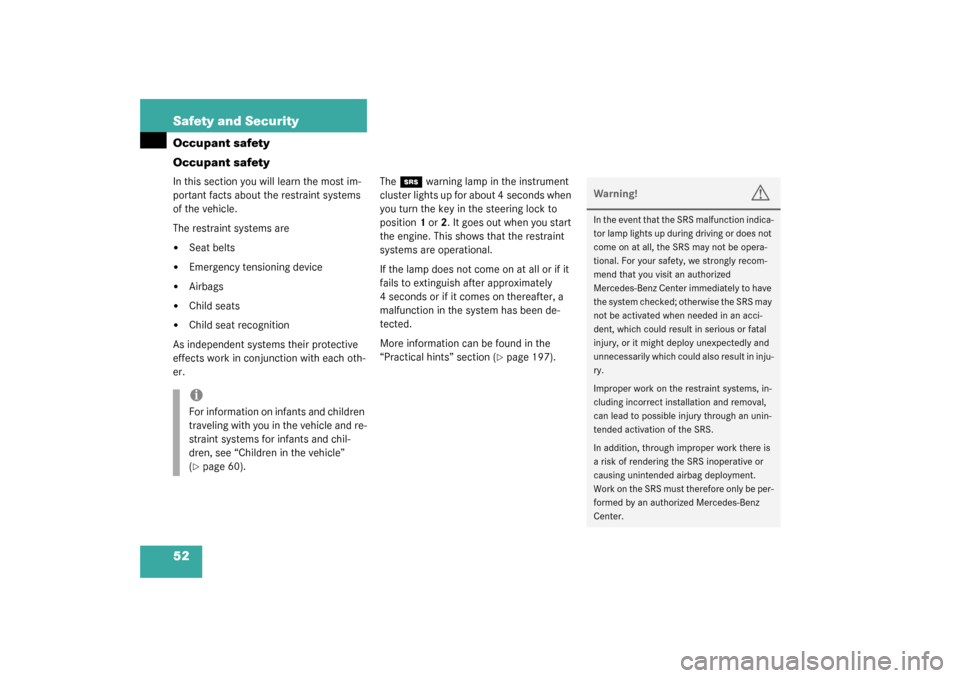Page 40 of 304

40 Getting startedDrivingStarting the engine Manual transmission
Gearshift pattern for manual transmissionStarting�
Make sure that the gearshift lever is in
Neutral position.
�
Do not depress the accelerator.
�
Fully depress clutch pedal.
Otherwise the engine cannot be start-
ed due to the integrated safety inter-
lock.
�
Turn the key in the steering lock to
position3. Release when the engine is
firing regularly (
�page 29).
For information on turning off the engine
(
�page 48).
More information can be found in the
“Controls in detail” section (
�page 91).
Warning!
G
Inhalation of exhaust gas is hazardous to
your health. All exhaust gas contains carbon
monoxide, and inhaling it can cause uncon-
sciousness and lead to death.
Do not run the engine in confined areas
(such as garage) which are not properly ven-
tilated. If you think that exhaust gas fumes
are entering the vehicle while driving, have
the cause determined and corrected imme-
diately. If you must drive under these condi-
tions, drive only with at least one window
fully open.
Page 41 of 304

41 Getting started
Driving
Automatic transmission*Gearshift pattern for automatic
transmissionPPark position with selector lever lock
RReverse gear
NNeutral
DDrive positionStarting
�
Make sure that the gear selector lever
is set toP .
�
Do not depress the accelerator.
�
Turn the key in the steering lock to
position3. Release when the engine is
firing regularly (
�page 29).
�
Depress the brake pedal.
The selector lever lock is released.
For information on turning off the engine
(
�page 48).
More information can be found in the
“Controls in detail” section (
�page 93).Starting difficulties
If the engine does not start as described,
carry out the following steps:
�
Turn the key in steering lock to
position0 and repeat starting proce-
dure.
Remember that extended starting at-
tempts can drain the battery
�
Get a jump start (
�page 247).
If the engine does not start after several
starting attempts, there could be a mal-
function in the engine electronics or in the
fuel supply system.
�
Notify an authorized Mercedes-Benz
Center.!Ensure that the brake pedal is de-
pressed when starting the engine.
Page 43 of 304

43 Getting started
Driving
Switching on headlampsExterior lamp switch1Off
2Low beam headlamps on�
Turn the switch to
B
.More information can be found in the
“Controls in detail” section (
�page 83).
Turn signals and high beam
The combination switch is on the left of the
steering column.Combination switch1Turn signals, right
2Turn signals, left�
Press the combination switch up1 or
down2.
Warning!
G
Vehicles with automatic transmission: It is
dangerous to shift the selector lever out ofP
orN if the engine speed is higher than idle
speed. If your foot is not firmly on the brake
pedal, the vehicle could accelerate quickly
forward or in reverse. You could lose control
of the vehicle and hit someone or some-
thing. Only shift into gear when the engine is
idling normally and when your right foot is
firmly on the brake pedal.!Simultaneously depressing the acceler-
ator pedal and applying the brake re-
duces engine performance and causes
premature brake and drivetrain wear.
Warning!
G
On slippery road surfaces, never downshift
in order to obtain braking action. This could
result in drive wheel slip and reduced vehi-
cle control. Your vehicle’s ABS will not pre-
vent this type of loss of control.
Page 45 of 304

45 Getting started
Driving
Single wipe�
Press switch briefly in the direction of
arrow2.
The windshield wipers wipe one time
without washer fluid.
Wiping with windshield washer fluid
�
Push switch in the direction of arrow2
past the resistance point.
The windshield wiper operates with
washer fluid.
Problems while driving
The engine runs erratically and misfires�
An ignition cable may be damaged.
�
The engine electronics may not be op-
erating properly.
�
Unburned gasoline may have entered
the catalytic converter and damaged it.
�
Give very little gas.
�
Have the problem repaired by an au-
thorized Mercedes-Benz Center as
soon as possible.
!If leaves, snow, etc. block the wind-
shield wipers, switch off the wipers.�
For safety reasons, withdraw the
key from the steering lock. Remove
blockage.
�
Turn the windshield wipers on
again.
If windshield wipers fail to function at
all in switch positionI,
�
set the combination switch to the
next highest wiper speed.
�
have the windshield wipers
checked at the nearest authorized
Mercedes-Benz Center.
Page 46 of 304
46 Getting startedDrivingThe coolant temperature is over 248°F
(120°C)
The coolant is too hot and is no longer
cooling the engine.�
Stop the vehicle as soon as possible
and turn off the engine. Allow engine
and coolant to cool.
�
Check the coolant level and add cool-
ant if necessary (
�page 176).In case of accident
If the vehicle is leaking gasoline:
�
Do not start the engine under any cir-
cumstances.
�
Notify local fire and/or police authori-
ties.
If the extent of the damage cannot be de-
termined:
�
Notify an authorized Mercedes-Benz
Center.
If no damage can be determined on the
�
major assemblies
�
fuel system
�
engine mount
�
Start the engine in the usual manner.
Page 47 of 304

47 Getting started
Parking and locking
Parking and locking
You have now completed your first drive.
You have properly stopped and parked
your vehicle. End your drive as follows.
Parking brake
1Brake lever
2Release button�
Pull up brake lever1 firmly.
When the engine is running, the indica-
tor lamp
;
(USA only) or
3
(Canada only) in the instrument cluster
will be illuminated.
Warning!
G
Wait until the vehicle is stationary before re-
moving the key from the starter switch. The
vehicle cannot be steered when the key is
removed.Warning!
G
With the engine not running, there is no
power assistance for the brake and steering
system. In this case, it is important to keep
in mind that a considerably higher degree of
effort is necessary to stop or steer the vehi-
cle.
Warning!
G
Do not park this vehicle in areas where com-
bustible materials such as grass, hay or
leaves can come into contact with the hot
exhaust system, as these materials could be
ignited and cause a vehicle fire.
To reduce the risk of personal injury as a re-
sult of vehicle movement, before turning off
the engine and leaving the vehicle always:�
Keep right foot on brake pedal.
�
Pull up the brake lever firmly.
�
Move the selector lever to positionP
(manual transmission: first or reverse
gear).
�
Slowly release brake pedal.
�
When parked on an incline, turn front
wheels towards the road curb.
�
Turn the key to steering lock position0
and remove.
Page 48 of 304

48 Getting startedParking and locking
Switching off headlamps�
Turn the exterior lamp switch to
M
(
�page 43).
More information can be found in the
“Controls in detail” section (
�page 83).
Turning off engine �
Place the gear selector lever in
positionP (manual transmission: first
or reverse gear).
�
Turn the key in the steering lock to
position0 (
�page 29) and remove it.
The immobilizer is activated.
Warning!
G
When leaving the vehicle, always remove the
key from the steering lock and lock the vehi-
cle. Do not leave children unattended in the
vehicle, or with access to an unlocked vehi-
cle. Children could release the parking
brake and/or move the gear selector lever
from positionP, either of which could result
in an accident and/or serious injury.
Warning!
G
Getting out of your vehicle with the selector
lever not fully engaged in positionP is dan-
gerous. Also, when parked on an incline,
positionP alone may not prevent your vehi-
cle from moving, possibly hitting people or
objects.
Always set the parking brake in addition to
shifting to positionP (manual transmission:
first or reverse gear).
When parked on an incline, turn front wheel
towards the road curb.
iAlways set the parking brake in addi-
tion to shifting to positionP (manual
transmission: first or reverse gear). iOn steep slopes, turn the front wheels
towards the road curb.
Page 52 of 304

52 Safety and SecurityOccupant safety
Occupant safetyIn this section you will learn the most im-
portant facts about the restraint systems
of the vehicle.
The restraint systems are�
Seat belts
�
Emergency tensioning device
�
Airbags
�
Child seats
�
Child seat recognition
As independent systems their protective
effects work in conjunction with each oth-
er.The
1
warning lamp in the instrument
cluster lights up for about 4 seconds when
you turn the key in the steering lock to
position1 or2. It goes out when you start
the engine. This shows that the restraint
systems are operational.
If the lamp does not come on at all or if it
fails to extinguish after approximately
4 seconds or if it comes on thereafter, a
malfunction in the system has been de-
tected.
More information can be found in the
“Practical hints” section (
�page 197).
iFor information on infants and children
traveling with you in the vehicle and re-
straint systems for infants and chil-
dren, see “Children in the vehicle”
(�page 60).
Warning!
G
In the event that the SRS malfunction indica-
tor lamp lights up during driving or does not
come on at all, the SRS may not be opera-
tional. For your safety, we strongly recom-
mend that you visit an authorized
Mercedes-Benz Center immediately to have
the system checked; otherwise the SRS may
not be activated when needed in an acci-
dent, which could result in serious or fatal
injury, or it might deploy unexpectedly and
unnecessarily which could also result in inju-
ry.
Improper work on the restraint systems, in-
cluding incorrect installation and removal,
can lead to possible injury through an unin-
tended activation of the SRS.
In addition, through improper work there is
a risk of rendering the SRS inoperative or
causing unintended airbag deployment.
Work on the SRS must therefore only be per-
formed by an authorized Mercedes-Benz
Center.